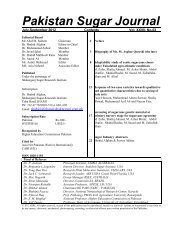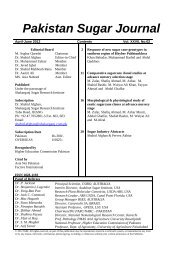Pakistan Sugar Journal
April-June 2010 - Shakarganj Group
April-June 2010 - Shakarganj Group
Create successful ePaper yourself
Turn your PDF publications into a flip-book with our unique Google optimized e-Paper software.
POPULATION GROWTH AND DEMAND AND SUPPLY SITUATION OF SUGAR<br />
AND GUR IN BANGLADESH<br />
ABSTRACT<br />
G. M. Monirul Alam, M. M. Alam and M. A. S. Miah<br />
Bangladesh <strong>Sugar</strong>cane Research Institute, Ishurdi, Pabna, Bangladesh<br />
During 1990-91 to 2005-06 average total area under sugarcane was 89 thousand hectares only<br />
1.07 per cent of the total cultivated area where as production was 4167 thousand tons. For the<br />
same period average yield of sugarcane was 46.6 t ha-1 and sugar production was 170<br />
thousand tons. Availability of sugar both from internal production and importation during the<br />
aforementioned period was 0.49 million tons on an average. Mean domestic production and<br />
importation of sugar and jaggery (locally called ‘gur’) were 0.89 million tons met 54% of the<br />
country’s demand and deficit was 0.75 million tons (45% of the internal demand). Per capita<br />
availability of sugar and gur were 3.92 kg and 3.17 kg as against demand of 10 kg sugar and<br />
3 kg gur respectively during the period. The growth rates of sugarcane cultivation area,<br />
sugarcane production, yield, gur production and sugar import during the aforementioned<br />
period were -1.11, -1.01, 0.62, - 4.37, 0.18 and 18.82 % respectively. Date palm and palmyra<br />
palm plantation may be an alternative source of sugar and gur to meet up the increasing<br />
demand of sugar and gur in Bangladesh.<br />
Key words: <strong>Sugar</strong>cane, sugar, gur, demand, supply, gap<br />
INTRODUCTION<br />
<strong>Sugar</strong> is indispensable for health and if it is not taken directly, it must be taken from other<br />
sources of carbohydrates in the food. Since sugar, as it is called, a cheap source of instant<br />
energy, a person should take it liberally. According to the nutritionists (CSIR, 1957), “a<br />
person requires a minimum of 44 Ib (20 kg) of sugar or equivalent quantity of gur per year in<br />
his (or her) diet”. It is believed that there is a strong positive relation between total sugar<br />
consumption and health standard of a nation. According to FAO recommendation (13.0 kg<br />
sugar per person per annum) at present Bangladesh requires 1.80 million tons of sugar for<br />
140 million people. The annual per capita consumption of sugar in the country is 5.80 kg<br />
(<strong>Sugar</strong> + gur in terms of sugar). In the neighboring countries as Sri Lanka, India and <strong>Pakistan</strong><br />
are 12.50 kg, 13.47 kg and 20.50 kg respectively, while in the developed countries between<br />
25-30 kg (Bench mark survey, 1996). Per capita consumption of sugar is very important in<br />
the context of health, IQ, calorie intake of the nations. Hence, it is necessary to produce more<br />
domestic sugar and gur to maintain our minimum health standard for our growing population<br />
through the increase production of sugarcane in Bangladesh.<br />
In Bangladesh, sugar industry is the most important agro-based rural industry. But now the<br />
existence of this industry is questionable due to its huge losses each year. Although, more<br />
than 0.6 million farm-families are dependent on sugar industry for their subsistence. Most of<br />
the sugar mills are located in the North-western zones of the country where concentration of<br />
sugarcane cultivation is high. Currently, on an average the principal raw materials, sugarcane,<br />
for producing sugar is growing in 0.18 million hectare of land of which almost 50% is located<br />
in the sugar mills zones, where sugarcane is mostly used for sugar production and remaining<br />
50% is situated in the non-mill zones, where sugarcane is mostly diverted for gur and juice<br />
production (Bench mark survey of <strong>Sugar</strong>cane, 1996). <strong>Sugar</strong> industry added value to final<br />
output in the form of sugar and its by-product. Further it is value added in our national<br />
economy when the final output is marketed to the consumer via dealer (distributer,






